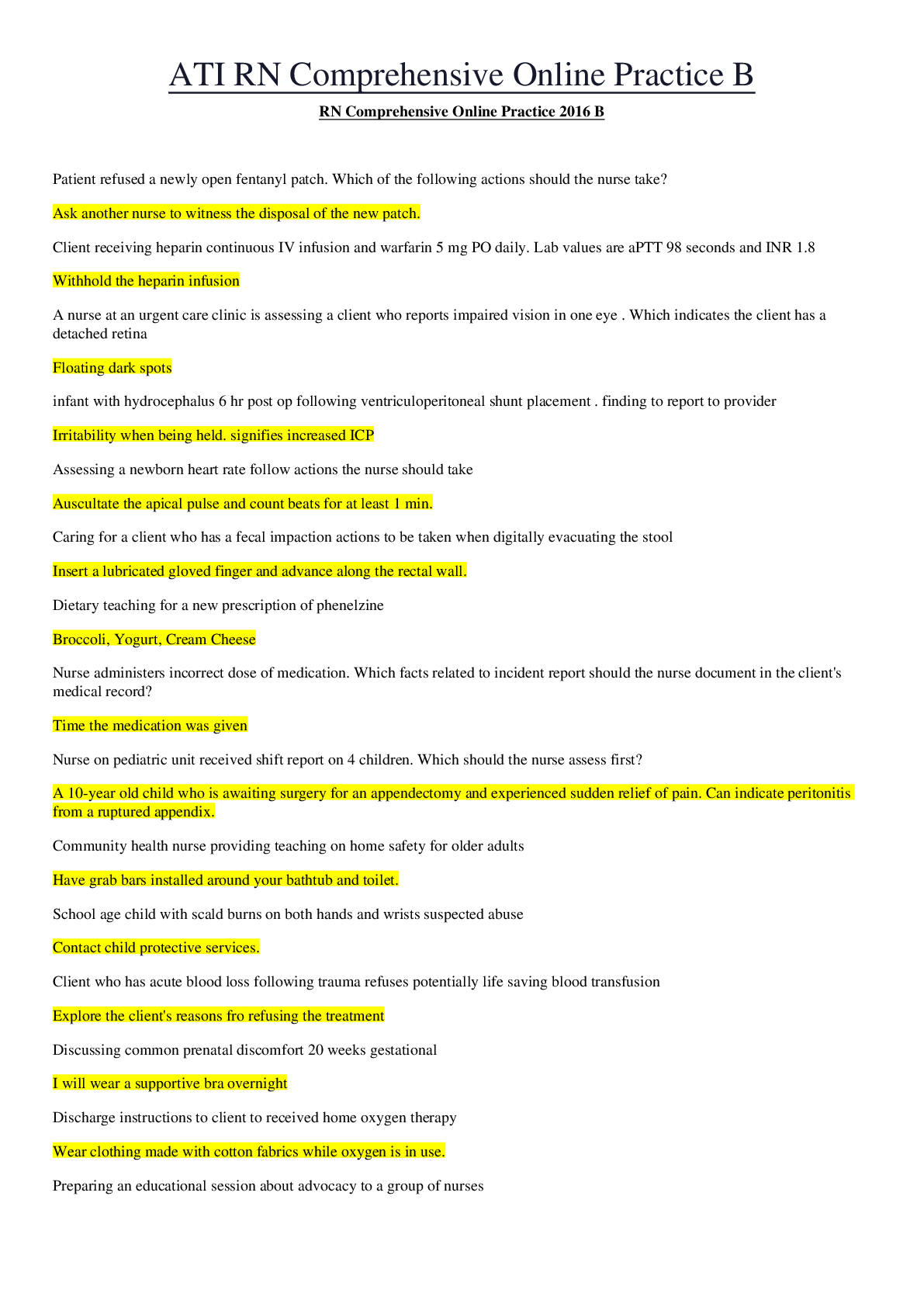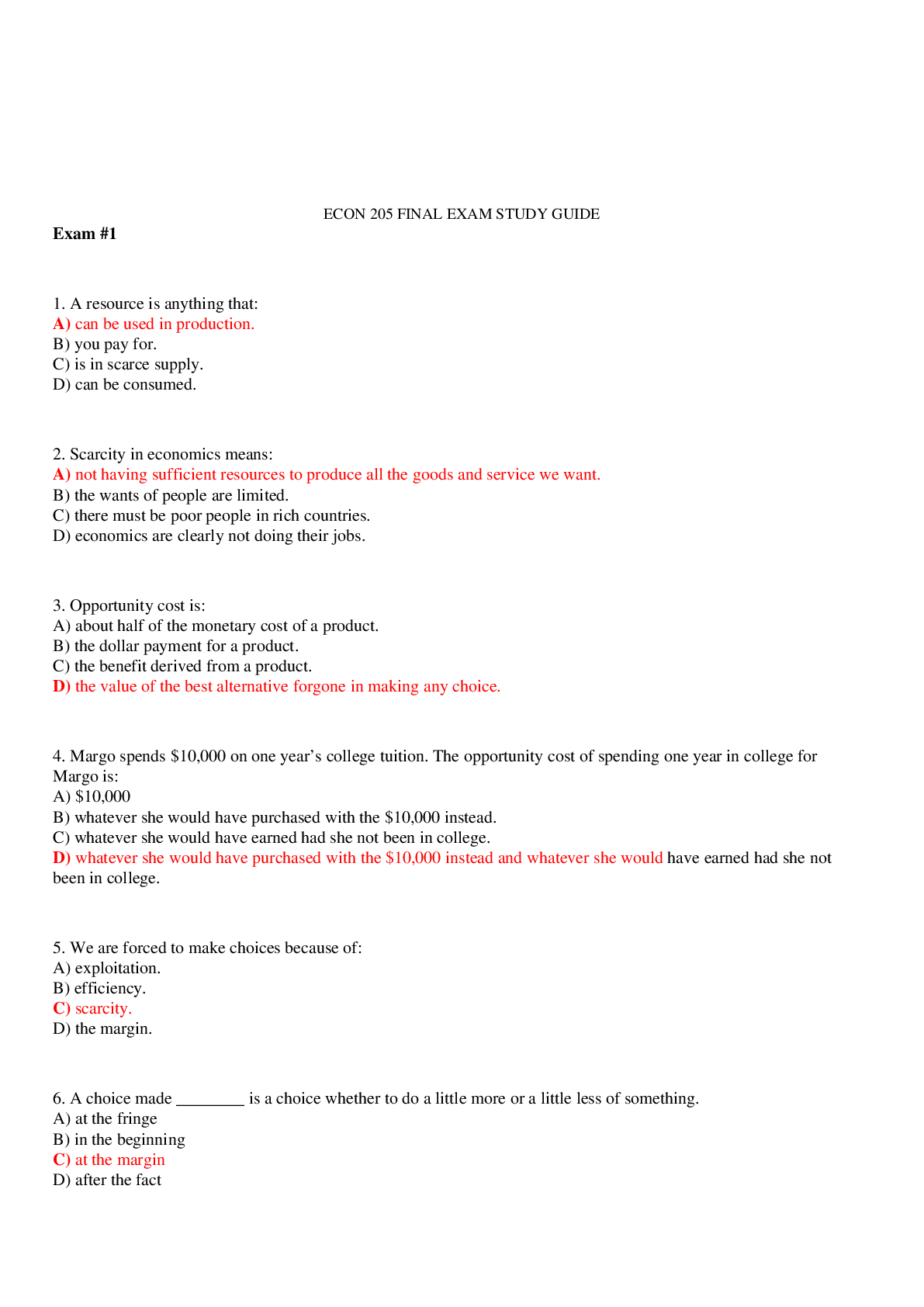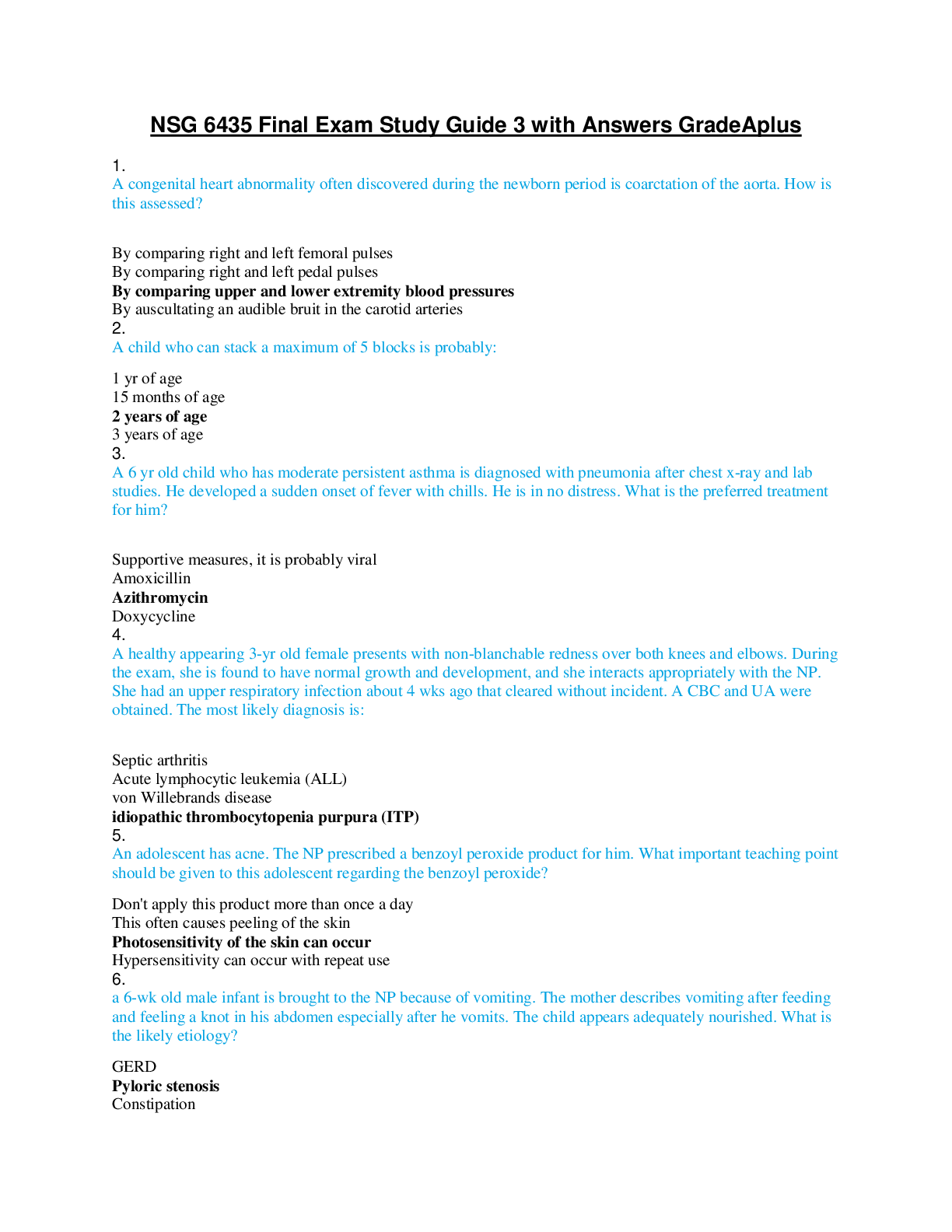*NURSING > EXAM > NR 511 Final Exam Study Guide (Winter 2019) – Chamberlain college of nursing | NR511 Final Exam St (All)
NR 511 Final Exam Study Guide (Winter 2019) – Chamberlain college of nursing | NR511 Final Exam Study Guide (Winter 2019)
Document Content and Description Below
NR511 Final Exam Study Guide (Winter 2019) – Chamberlain college of nursing Week 1 to week 6 Week 1 1. Define diagnostic reasoning -To solve problems, to promote health, and to screen for d... isease or illness all require a sensitivity to complex stories, to contextual factors, and to a sense of probability and uncertainty. -Diagnostic reasoning can be seen as a kind of critical thinking. Critical thinking involves the process of questioning one’s thinking to determine if all possible avenues have been explored and if the conclusions that are being drawn are based on evidence. Diagnostic reasoning then includes a systematic way of thinking that evaluates each new piece of data as it either supports some diagnostic hypothesis or reduces the likelihood of others. 2. Discuss and identify subjective & objective data -Subjective: -reports -complains of -tells you in response to your questions. -Includes ROS, CC, and HPI -Objective: -what you can see, hear, or feel as part of your clinical exam. -It also includes laboratory data and test results. 3. Discuss and identify the components of the HPI -O: Onset of CC -L: Location of CC -D: Duration of CC -C: Characteristics of CC -A: Aggravating factors for CC -R: Relieving factors for CC -T: Treatments tried for CC -S: Severity of CC 4. Describe the differences between medical billing and medical coding Medical coding: is the use of codes to communicate with payers about which procedures were performed and why. -Medical billing: is the process of submitting and following up on claims made to a payer in order to receive payment for medical services rendered by a healthcare provider. 5. Compare and contrast the 2 coding classification systems that are currently used in the US healthcare system -The CPT system offers the official procedural coding rules and guidelines required when reporting medical services and procedures performed by physician and non-physician providers. -CPT codes are recognized universally and also provide a logical means to be able to track healthcare data, trends, and outcomes. -ICD-10 codes are shorthand for the patient’s diagnoses, which are used to provide the payer information on the necessity of the visit or procedure performed. 6. Discuss how specificity, sensitivity & predictive value contribute to the usefulness of the diagnostic data -Specificity of a test, we are referring to the ability of the test to correctly detect a specific condition. -Predictive value is the likelihood that the patient actually has the condition and is, in part, dependent upon the prevalence of the condition in the population. -When a test is very sensitive, we mean it has few false negatives. 7. Discuss the elements that need to be considered when developing a plan Acknowledge the list -Negotiate what to cover -Be Honest -Make a follow-up 8. Describe the components of Medical Decision Making in E&M coding - There are three key components that determine risk-based E&M codes. -History -Physical -Medical Decision Making (MDM) E&M coding requires a medical decision maker -Medical decision making is another way of quantifying the complexity of the thinking that is required for the visit. -Complexity of a visit is based on three criteria: -Risk -Data -Diagnosis -Now, medical decision making is a special category. Why is this so important? Well, the MDM score gives us credit for the excess work involved in management of a more complex patient. 9. Correctly order the E&M office visit codes based on complexity from least to most complex 99212 - 99214 10. Discuss a minimum of three purposes of the written history and physical in relation to the importance of documentation -It is an important reference document that gives concise information about a patient's history and exam findings. -It outlines a plan for addressing the issues that prompted the visit. This information should be presented in a logical fashion that prominently features all data immediately relevant to the patient's condition. -It is a means of communicating information to all providers who are involved in the care of a particular patient. -It is an important medical-legal document -It is essential in order to accurately code and bill for services. 11. Accurately document why every procedure code must have a corresponding diagnosis code -Every procedure code needs a diagnosis to explain the necessity whether the code represents an actual procedure performed or a nonprocedural encounter like an office visit. 12. Correctly identify a patient as new or established given the historical information • Patient status -New patient: one who has not received professional service from a provider from the same group practice within the past 3 years. -Established patient of your practice: has received professional service from a provider of your office within the last 3 years 13. Identify the 3 components required in determining an outpatient, office visit E&M code -Place of service -Type of service -Inpatient -Consultation’s -Outpatient -Office visit -Hospital admission -Patient status -New patient: one who has not received professional service from a provider from the same group practice within the past 3 years. -Established patient of your practice: has received professional 14. Describe the components of Medical Decision Making in E&M coding - There are three key components that determine risk-based E&M codes. -History -Physical -Medical Decision Making (MDM) E&M coding requires a medical decision maker -Medical decision-making is another way of quantifying the complexity of the thinking that is required for the visit. -Complexity of a visit is based on three criteria: -Risk -Data -Diagnosis -Now, medical decision making is a special category. Why is this so important? Well, the MDM score gives us credit for the excess work involved in management of a more complex patient. 15. Explain what a “well rounded” clinical experience means -Includes both children from birth through young adult visits for well child and acute visits, as well as adults for wellness and acute or routine visits 16. State the maximum number of hours that time can be spent “rounding” in a facility <25% 17. State 9 things that must be documented when inputting data into clinical encounter -date of service -visit E&M code (e.g., 99203) -age -gender and ethnicity -chief concern -procedures -tests performed or ordered -diagnoses -level of involvement 18. Identify and explain each part of the acronym SNAPPS -S: Summarize -N: Narrow -A: Analyze -P: Probe -P: Plan -S: Self-directed learning - - - - - - - - - - - - - - - - - - - - 8. Discuss an intervention to prevent HIV and HIV-associated behaviors *safe sex practices - latex condoms *needle exchange programs *universal testing of donated blood products *education to HIV positive women of childbearing age about c-sections, arv drugs for mother and baby *voluntary HIV testing a routine part of medical care *new models for HIV diagnosing outside medical setting *prevent new infection by working with HIV infected and their partners to minimize risk 9. Identify physical exam findings in the patient with HIV fever, sore throat, myalgia, headaches, cervical lymphadenopathy, night sweats, majority are asymptomatic flu-like sumptoms 6 days to 6 weeks after viral transmission dark purple colored spots (karposi's sarcoma) non-productive cough, SOB, and fever for several weeks pulmonary symptoms: pcp pneumonia, tb, bacterial pneumonia localized candida infections other STD's weight loss anemia, leukopenia, and/or thrombocytopenia 10. Describe symptoms, DDx, pathogens, testing, and treatment for the following conditions: Cellulitis, impetigo, MRSA, Bites (dogs, cats, humans), Erysipelas - Cellulitis o Pathogens ♣ Strep (A,B,C,G,F) ♣ Staph o Symptoms ♣ Skin erythema, edema, warmth, pain, possible fever ♣ Lymphangitis, lymphadenopathy, peau d’orange (orange peel texture) ♣ No fever/chills, localized symptoms only ♣ Underlying infection, lymphedema, venous insufficiency o Treatment ♣ I&D if abscess is involved Patients with cellulitis should be managed with empiric therapy for infection due to beta-hemolytic streptococci and methicillin-susceptible Staphylococcus aureus (MSSA) with: • Cephalexin 500 mg four times daily (alternative for mild penicillin allergy) • Clindamycin 300 mg to 450 mg four times daily (alternative for severe penicillin allergy) - Erysipelas o Pathogens ♣ Group A Strep o Symptoms ♣ Skin erythema, edema, warmth, pain, possible fever ♣ Lymphangitis, lymphadenopathy, peau d’orange (orange peel texture) ♣ Acute onset with systemic symptoms (fever, chills) ♣ Clear demarcation ♣ Butterfly involvement on face or ear o Milian’s Ear Sign ♣ Involvement of ear, classic for erysipelas o Treatment ♣ I&D if abscess is involved Patients with erysipelas should be managed with empiric therapy for infection due to beta-hemolytic streptococci with: ♣ Penicillin V potassium 500 mg orally every 6 hours ♣ Amoxicillin 875 mg twice daily ♣ Cephalexin 500 mg four times daily (alternative for mild penicillin allergy) ♣ Clindamycin 300 mg to 450 mg four times daily (alternative for severe penicillin allergy) - MRSA o Risk factors ♣ ATB use • Cephalosporins • Fluoroquinolones ♣ HIV infection ♣ Hemodialysis ♣ ECFs o Signs and Symptoms ♣ Skin abscess • Painful, fluctuant, erythematous nodule, with or without surrounding cellulitis • Spontaneous drainage may occur • Regional lymphadenopathy may be observed • Fever, chills, and systemic toxicity are unusual • Also manifested as furuncles (abscess of hair follicles) or carbuncles (coalesced masses of furuncles) ♣ Experts recommend oral ATB for patients undergoing I&D of an abscess if • Single abscess is equal or greater than 2cm or multiple lesions • Extensive surrounding cellulitis • Immunosuppression or systemic signs of toxicity (fever>100.5/38) • Presence of an indwelling medical device • High risk of transmission of S aureus to others o Athletes or military personnel ♣ ATB with coverage for CA-MRSA include • Bactrim DS 2x day • Doxycycline 100mg 2x day • Minocycline 200mg PO once, then 100mg Q12 hours • Clindamycin 300-450 mg 4xday ♣ Treatment should be offered for at least 5 days • Beta-lactam drug should be added if the abscess is peri-rectal or peri-oral - Impetigo o Primary ♣ Infection of previously normal skin o Secondary ♣ Infection arises at sites of minor skin trauma o Microbiology ♣ S. aureus ♣ Group A Strep (GAS) causes a minority of cases ♣ Occasionally MRSA o Signs/Symptoms ♣ Non-bullous impetigo • Most common form • Begins as papules – vesicles – pustules – thick, adherent golden crusts ♣ Bullous impetigo • Seen primarily in young children • Vesicles – flaccid bullae with clear yellow fluid – darker – thin brown crust o Treatment ♣ Topical choices • Mupirocin 3xday for 5 days • Retapamulin 2x day for 5 days ♣ Oral Treatment • Extensive impetigo and Ecthyma should be treated with an ATB effective for BOTH S. aureus and strep infections • Dicloxacillin and cephalexin for 7 days are appropriate treatments • PCN is the preferred agent if only strep are detected • MRSA impetigo can be treated with doxycycline, clindamycin, or Bactrim - Human Bites o Pathogens ♣ Staph aureus ♣ Strep o Agent of choice: Amoxicillin/clavulanate 875/125 2xday - Cat & Dog Bites o Pathogens ♣ Pasturella multocida & capnocytophaga canimorsis o Alternative ATB w/ activity against Pasturella ♣ Doxycycline 100mg 2xday ♣ Bactrim DS 2xday ♣ PCN VK 500mg 4xday ♣ Ciprofloxacin 500mg 2xday • PLUS o Metronidazole 500mg 3xday o Clindamycin 450mg 3xday - ALL bites treatment considerations o Treatment ♣ Copiously irrigate with sterile saline ♣ Remove grossly visible debris ♣ Prophylactic ATB are given if • Deep puncture wounds • Wounds requiring surgical repair • Moderate to severe wounds w/ associated crush injury • Wounds in areas of underlying venous and/or lymphatic compromise • Wounds on the hands or in close proximity to a bone or joint • Wounds on the face or in the genital area • Immunocompromised hosts [Show More]
Last updated: 2 years ago
Preview 1 out of 62 pages

Buy this document to get the full access instantly
Instant Download Access after purchase
Buy NowInstant download
We Accept:

Reviews( 0 )
$18.00
Can't find what you want? Try our AI powered Search
Document information
Connected school, study & course
About the document
Uploaded On
Jun 25, 2020
Number of pages
62
Written in
Additional information
This document has been written for:
Uploaded
Jun 25, 2020
Downloads
0
Views
98








 – University of the People.png)

















